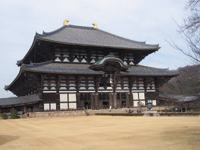Nara
Back to Contents of Issue: April 2005
|
|
|
|
by Landon Thorpe |
|
 It was when I first visited Nara during a rainy June that I saw what hungry deer can do to a poor, naive girl and was knocked out of my chair by a pickle. It was when I first visited Nara during a rainy June that I saw what hungry deer can do to a poor, naive girl and was knocked out of my chair by a pickle.
One cool, cloudy Sunday a friend and I headed to Nara. I immediately realized the city was one of the more exquisite places in Japan. Maybe it was because the weather was nice for walking and Nara had such a relaxed environment, like an extended park space surrounding some excellent temples. Then again, maybe it was all of the friendly deer. That's right. Deer roam the city. I even saw a group of them using the crosswalk when the pedestrian sign was lit. These deer are mostly well mannered, but they become aggressive when approaching one for food. They prefer shikasenbei (deer rice crackers), to be exact, and this is when things can get ugly. I saw a herd of them attack a woman who held about a dozen shikasenbei in her hands. She dropped them and ran for her life. We avoided marauding groups of deer and made our way to Todai-ji. This monolithic temple is probably the most striking building I've visited so far in Japan. Housing the country's biggest Buddha is one of the world's largest wooden structures. The brown wood of the entrance gate shows the weather-beaten remnants of red and white coats of paint. The entrance gate is enormous, as is everything in this complex, and the carved wooden guardians are imposing. A path through a sward of grass leads to the colossal building housing the Daibutsu (Great Buddha). This Buddha, to my eyes, had South Asian features, and revealed Nara's primitive Buddhism. Most of the religious buildings and icons in the Nara region were made before Buddhism had been thoroughly assimilated into Japanese culture. Remnants of the religion's dissemination from India through China to Japan were still noticeable. The interior was incense-filled and dark save for an occasional shaft of sunlight illuminating a towering wooden guardian.  Before we left Nara, my friend and I tried a kaiseki meal at a well-known restaurant called Tonojaya. Kaiseki is a traditional Japanese meal consisting of a succession of small courses. We ordered the lunch bento, though, where all the courses are served together. We sat in a private room with arranged flowers in an alcove and etchings on the tile wainscoting. About twenty tiny portions of food were arranged on our plates. The largest was a bowl of soup consisting of rice and a weak green tea broth. A smaller bowl contained osuimono, the kind of consomm? with seaweed and green onions one finds at many Japanese restaurants in America.
There was also sushi wrapped in a green leaf, mixed vegetables with raw fish that had been "cooked" in citrus juice, konnyaku (a kind of calorie-free grey jelly), and shishito (a vegetable that looked like a jalapeno but had a very subtle taste). For dessert there was warabimochi, a favorite of mine. This soft, sweet block of pounded rice dusted with spiced rice flour tastes a bit like cinnamon. It almost melts in your mouth and has a wonderfully creamy texture. The meal was served with plain brown tea and a shot of umeshu, Japanese plum wine. Before we left Nara, my friend and I tried a kaiseki meal at a well-known restaurant called Tonojaya. Kaiseki is a traditional Japanese meal consisting of a succession of small courses. We ordered the lunch bento, though, where all the courses are served together. We sat in a private room with arranged flowers in an alcove and etchings on the tile wainscoting. About twenty tiny portions of food were arranged on our plates. The largest was a bowl of soup consisting of rice and a weak green tea broth. A smaller bowl contained osuimono, the kind of consomm? with seaweed and green onions one finds at many Japanese restaurants in America.
There was also sushi wrapped in a green leaf, mixed vegetables with raw fish that had been "cooked" in citrus juice, konnyaku (a kind of calorie-free grey jelly), and shishito (a vegetable that looked like a jalapeno but had a very subtle taste). For dessert there was warabimochi, a favorite of mine. This soft, sweet block of pounded rice dusted with spiced rice flour tastes a bit like cinnamon. It almost melts in your mouth and has a wonderfully creamy texture. The meal was served with plain brown tea and a shot of umeshu, Japanese plum wine.
The most surprising dish was a local variety of pickle called Narazuke. I expected the usual sour daikon radish taste, but this blood-red slice of pickled eggplant had something else in store. I took a bite, and a rich, vaporous sensation flooded my mouth. I was taken aback. Never had such flavorful Japanese food found its way to my palate. I asked our server how Narazuke was made. First eggplant or cucumber is covered with salt, she explained. Next it is thoroughly rinsed, and then pickled in up to three different kinds of sake. One can taste it all -- the sweet and the salt and the alcohol. It knocked me off my chair. Or, rather, since I was sitting on tatami, I should say I was floored. |
|
Note: The function "email this page" is currently not supported for this page.






